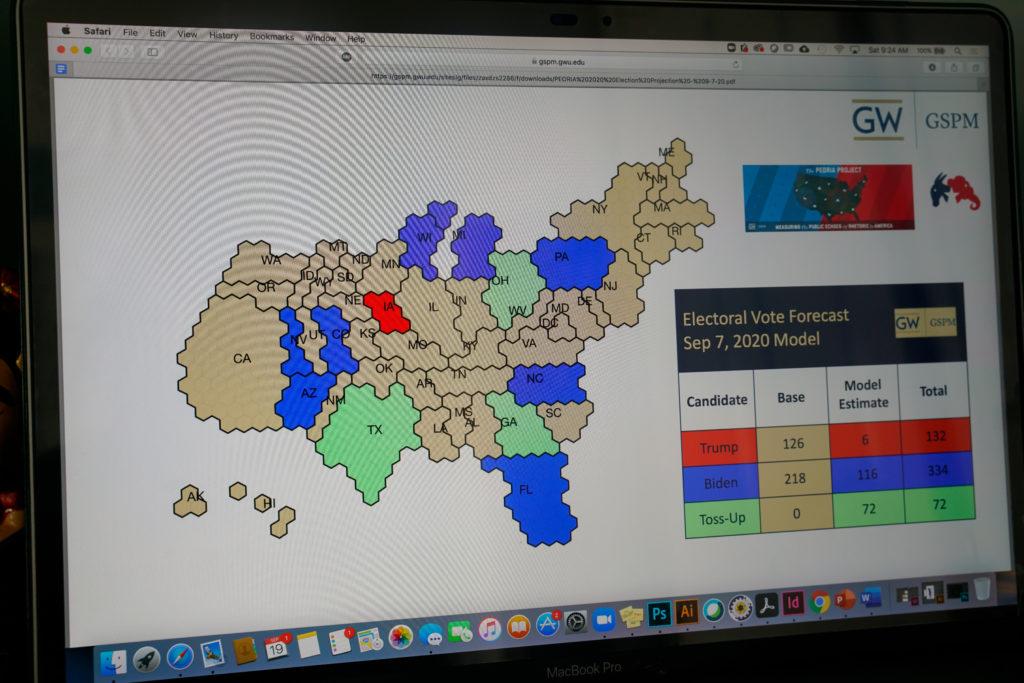Researchers in the Graduate School of Political Management are using Twitter data to predict the outcome of the 2020 presidential election.
The Public Echoes of Rhetoric in America Project is tracking Twitter topics and conversations related to the November general election to predict voter behavior and to determine which candidate will win electoral college votes from battleground states like Arizona and Colorado. Researchers involved with the project said they can improve upon existing forecasts for the presidential election by incorporating social media discourse like discussions of and reactions to the election and the candidates.
Michael Cornfield, the director of the PEORIA project and an associate professor of political management, said he and GSPM Director Lara Brown are analyzing Twitter data to build an improved election forecast model using tweets and public opinion.
“Dr. Brown and I formed the project five years ago to explore the potential of social media metrics as a new methodological window on public opinion,” he said in an email.
Researchers factored a state-level partisan lean based on past elections, polls, unemployment rates since January and national favorability ratings for each candidate into the forecast model, in addition to Twitter data, according to the project’s reports.
Cornfield said voters should pay attention to factors that may impact the outcome of the election like endorsements by prominent figures and the number of requested absentee ballots by political parties in certain states, both of which he said Democrats currently “hold the edge” in.
Researchers from the PEORIA project began releasing predictions for the 2020 Democratic primaries in February and created a weekly Tweeterboard covering the election last August.
Cornfield said the weekly Tweeterboard is a “fun offshoot” of PEORIA’s main forecast model and is set to make a return this week to examine the number of tweets mentioning each candidate in battleground states.
“If we detect an interesting pattern or change, we will delve into those tweets and examine their authors and content,” he said.
The most recent report from Sept. 9 predicts that former Vice President Joe Biden will win the Electoral College and eight out of the 12 potential swing states. Iowa is the only state to lean toward President Donald Trump with Texas, Georgia and Ohio as tossups, the report states.
The project released its first predictions on the presidential election on Aug. 11 and has had two other reports since then with limited changes.
Meagan O’Neill, the leading researcher on the project, said PEORIA’s model offers a forecast different from other popular election-predicting websites, like FiveThirtyEight or RealClearPolitics, by including an analysis of trends from Twitter.
“We’re specifically interested in any dynamics or movements in the election and what that means in terms of the Twitter data,” she said. “For example, when we suddenly see a spike in our prediction, we can log onto Twitter and pull those tweets in order to see what might’ve caused that spike so that it’s more about the public conversation about the campaign.”
O’Neill said the project is very “transparent” about its methodology since the information researchers are including is easily accessible by the public. She said researchers are working with Brandwatch, a digital consumer intelligence company that collects and analyzes the Twitter data they use, which she said mitigates many of the concerns surrounding bots and fake accounts on Twitter skewing the discussion online.
O’Neill said researchers for the project are predicting results nationwide but specifically selected 12 battleground states – Arizona, Colorado, Florida, Georgia, Iowa, Michigan, North Carolina, Nevada, Ohio, Pennsylvania, Texas and Wisconsin – earlier in March to examine in depth. She said either candidate can win these states after reviewing their prior voting history and consulting with experts and other forecast models.
O’Neill said the researchers intended to release weekly reports, but due to limited changes in the race, they are now releasing a new report with updated predictions every two weeks.
She said despite the election being fewer than 50 days away, there does not seem to be any major changes in the reports “from week to week,” but she noted there have been some since the release of their Sept. 9 report.
“It looks like North Carolina is moving toward a tossup state, and it looks like Texas is moving toward a safer Trump state,” she said.








